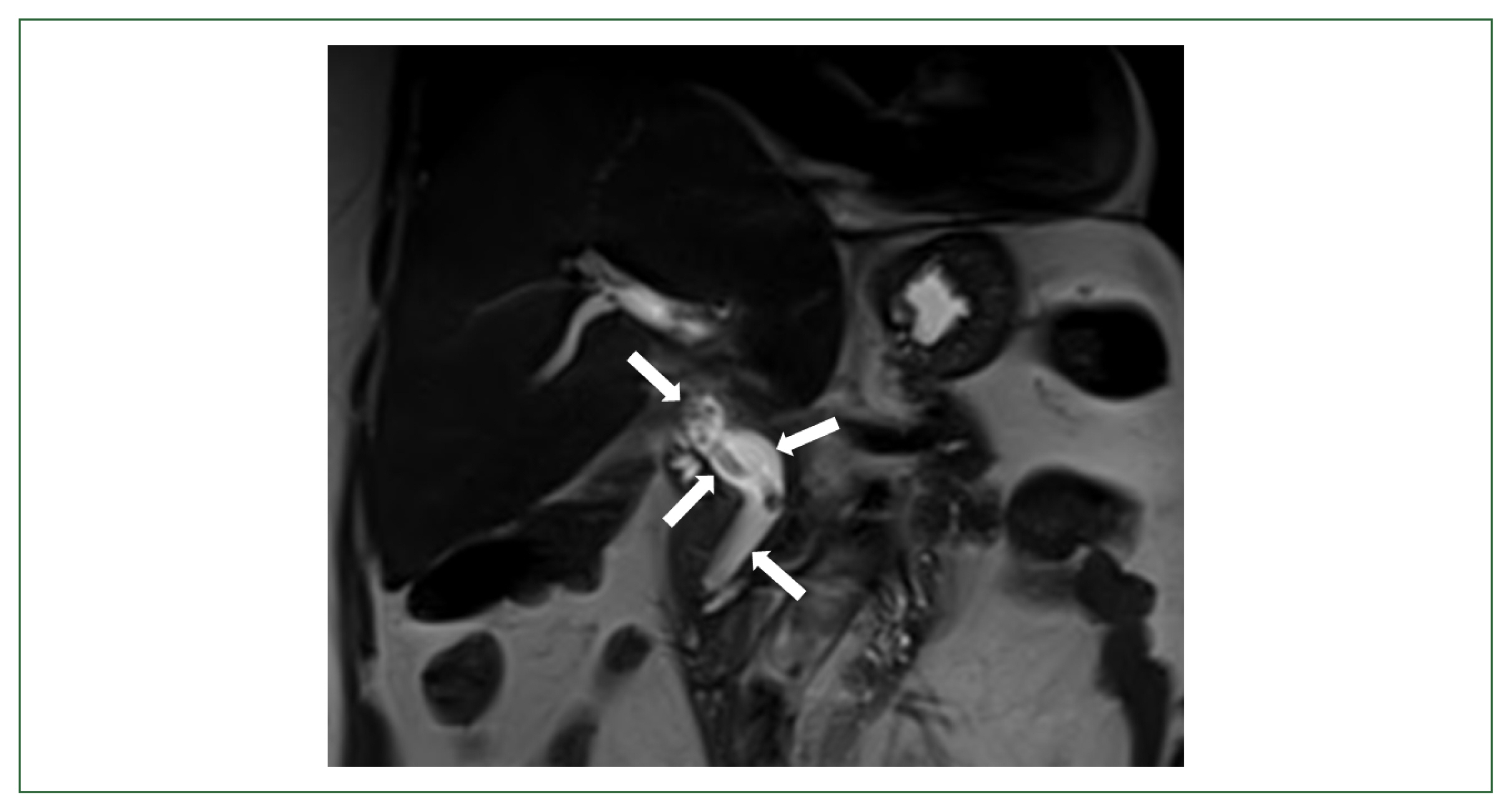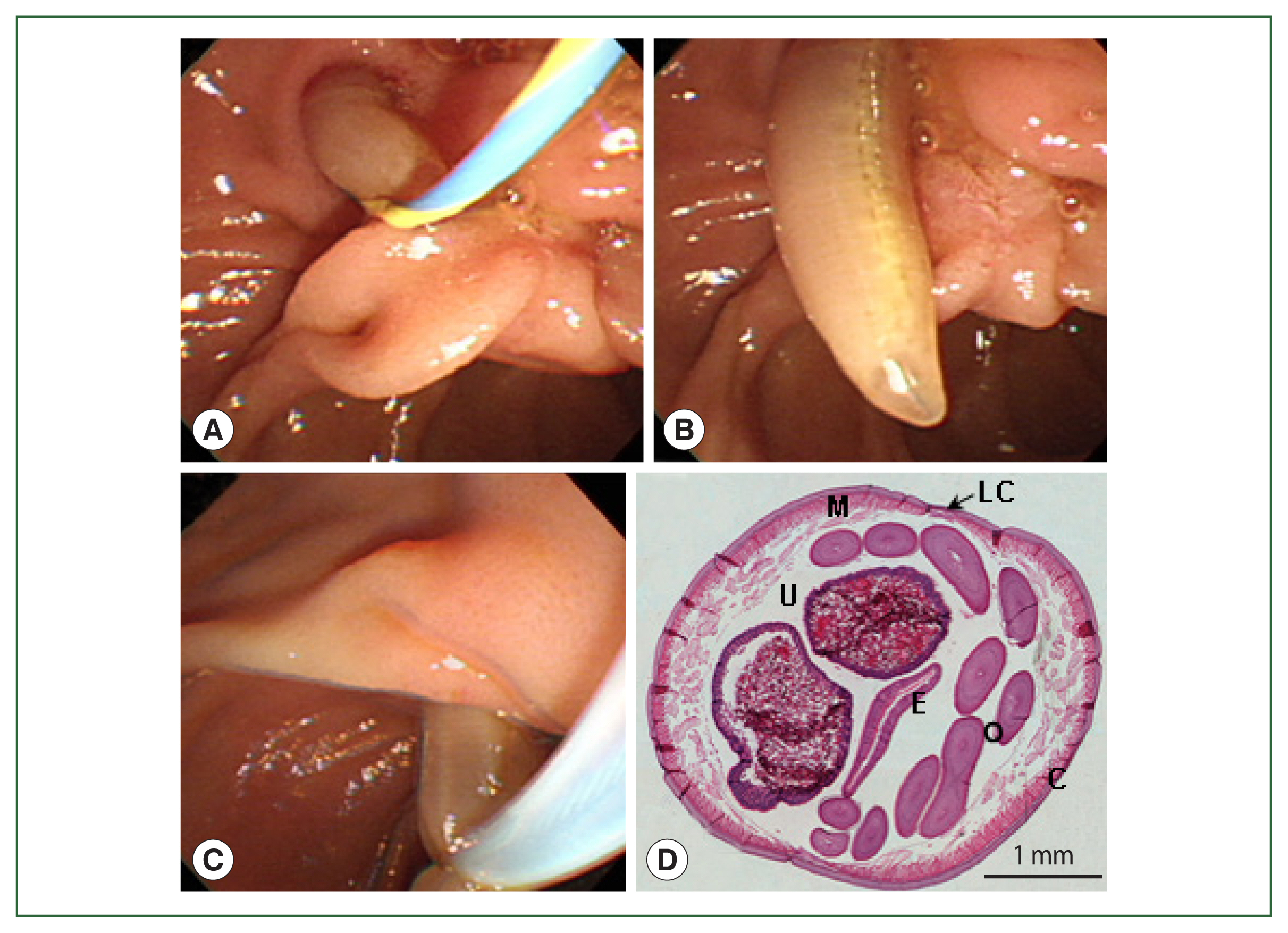Introduction
Ascaris lumbricoides is one of the commonest helminths worldwide which infects the human small intestine [1]. The infection used to be prevalent in Korea until the 1970s but rapidly declined as the social environment improved [2]. Most patients with intestinal ascariasis remain asymptomatic due to negligible parasite load [2]. However, the worms sometimes migrate to extraintestinal organs and cause ectopic ascariasis in the form of acute pancreatitis, liver abscess, or biliary stone [3]. Biliary ascariasis is a rare manifestation that can become a serious illness; however, most physicians in developed countries may not suspect it because of its rare incidence [3].
Notably, biliary ascariasis may be mistaken for the biliary stent on imaging due to its resemblance with the structure and shape of roundworms. There are reports of a few cases of biliary ascariasis mimicking the biliary stent diagnosed with or without endoscopic retrograde cholangiopancreatography (ERCP) [4,5]. However, biliary ascariasis mistaken for a biliary stent on magnetic resonance cholangiopancreatography (MRCP) has never been reported in Korea. Herein, we report a rare case of biliary ascariasis which was radiologically misdiagnosed as a biliary stent in a patient with a history of hepatic resection.
Case Description
In 2017, a 72-year-old female visited our outpatient clinic for pain in the right upper quadrant and epigastric area, accompanied by fever and a chilling sense since the last week. She had undergone ERCP in 1999 for common bile duct (CBD) stones and another ERCP and cholecystectomy in the next year for recurrent CBD stones. She had also undergone a left lateral sectionectomy of the liver for recurrent CBD and an intrahepatic duct (IHD) stone in 2015. She lived in an urban area and denied any history of eating freshwater fish. She was admitted for further evaluation.
Upon examination, her white blood cell count was 6,210×109/L (3.500–10.000×109/L) and the C-reactive protein level was 3 2.7 mg/L (0–5.0 mg/L). No specific abnormality was found on her liver function tests, apart from mildly elevated levels of gamma-glutamyl transferase to 64 IU/L (normal range: 4–34 IU/L); (aspartate transaminase=28 IU/L (normal range: 0–34 IU/L); alanine transaminase=27 IU/L (normal range: 0–40 IU/L); alkaline phosphatase= 110 IU/L (normal range: 30–120 IU/L); total bilirubin=0.6 mg/dL (normal range: 0.3–1.3 mg/dL), and direct bilirubin=0.2 (normal range: 0.0–0.4 mg/dL)).
Abdominopelvic computed tomography (APCT) revealed a recurrent CBD stone accompanied by suspicious sludge in the proximal IHD and CBD. After 3 days, T2-weighted coronal MRCP was done which revealed an approximately 4.5 cm hypointense (filling defects) tubular and tortuous structure over the CBD to the right IHD, with features of an internal stent (Fig. 1). Because of the patient’s surgical history, we assumed this to be an internal CBD stent inserted during her earlier surgeries. Two days later, ERCP was conducted, during which, surprisingly, a part of a parasitic worm was found in the duodenum, which was then gently extracted with a grasping snare (Fig. 2A–C). The removed worm was 10 cm long and 5 mm wide with a conical shape.
Histological examination of the cross-section of the worm stained with hematoxylin-eosin revealed characteristic features of Ascaris lumbricoides, including hypodermal polymyarian muscles, esophagus, oviducts, a pair of lateral cords, and uteri containing numerous underdeveloped eggs (Fig. 2D). Three days after the ERCP, no further events were observed. The patient was discharged with a prescription for albendazole for herself and her family members. When asked in detail about her medical history and dietary habits, she reported that she had been growing organic vegetables for 10 years on her private farm, using food waste as fertilizer instead of chemical fertilizer. The patient was followed up throughout 5 years at the outpatient clinic; no recurrence or other signs of infection, including in the stool examination, were detected.
Discussion
Ascariasis is one of the most common helminthic infections, especially in several Asian countries, possibly due to their traditional aquaculture and food conventions [6]. Over the past few decades, the incidence of ascariasis has decreased significantly in Korea due to improvements in personal hygiene and the Green Revolution [7]. However, biliary ascariasis, known as the most dreadful clinical manifestation, is still occasionally reported in Korea [8].
Ascaris lumbricoides usually infects the small intestine but can invade the biliary system [3,6]. The worm can invade the ampullary orifice causing biliary obstruction, manifesting as biliary colic, obstructive cholangitis, or pancreatitis [9]. Our patient had a history of farming organic vegetables on her private farm and using homemade organic fertilizer. We assume that she became infected with Ascaris lumbricoides by ingesting embryonated eggs spread due to this cultivation habit.
Ascariasis is diagnosed when the parasite’s eggs or adult worms are observed in stool microscopy tests [1]. In our patient, MRCP was conducted first followed by ERCP because of her history of recurrent CBD stones and cholangitis. On ERCP, we identified the worm and confirmed the diagnosis based on its typical histological features. Typical findings of biliary ascariasis on MRCP are a linear hyperintense tubular structure with a hypointense signal in the central area on T1-weighted images [8]. In our case, because of the patient’s surgical history and the tubular structure visualized on the MRCP, the worm was mistaken for a stent in her biliary tract at first. Since it is difficult to radiologically discriminate between parasites and stents, the surgeon conducting the ERCP must be clearly communicated about any possible stent placement prior to the procedure to avoid such misidentification.
In conclusion, if a patient presents with recurrent obstructive biliary disease, biliary ascariasis may be suspected based on the patient’s dietary and personal habits. A confirmatory diagnosis can be made based on imaging findings suggestive of tubular internal stentlike features.








